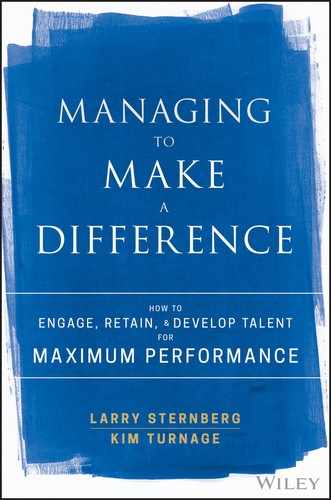Chapter 44
Focus on the Right Things
Managing to make a difference involves creating a culture that encourages people to become their best selves. Culture can be a slippery concept. Read any description of “great organizations” and you will find a laundry list of customs, beliefs, rituals, and perks touted as elements of their unique cultures—unlimited vacation, Ping Pong tables and pinball machines in brainstorming rooms, food trucks on Fridays, nap rooms to recharge. The list goes on. It can suck you in to focusing on the wrong things if you let it.
Beware!
Customs, beliefs, rituals, and perks become signs and expressions of cultural values. Understanding them helps to describe the culture. But they do not create and shape culture. Picking up practices from one team or organization and plunking them down into yours is not a great strategy for shaping your culture. Too often, looking from the outside in, even the best managers and leaders can miss that point.
For example, the “quality circle” became a formalized part of the culture of many Japanese companies in the 1960s, and played a key role in enabling those companies to produce very high quality products, including automobiles and consumer electronics. Because of this success, many U.S.-based companies tried to plunk quality circles into their culture, but the strategy did not work. Quality circles did not harmonize with the typical U.S.-based company culture. The cultural context to embrace that approach did not exist.
We want to help you focus on the right things. Based on what you have read so far in this book, it should come as no surprise that we define “the right things” as people.
If you want to shape your culture in ways that optimize performance and retention, you must start by focusing on the right things—your people—because culture arises organically from your people and your shared values. Culture is more than what you do or what you say. Culture is who you are. Questions like this can help you define key elements of your organization's culture:
- What unifies both the veterans and the newest recruits?
- What values drive them?
- What makes people stay?
- What attracts new people?
- What are the common characteristics among our top performers?
By all means, look outside your organization for ideas and inspiration for how to mold and optimize culture. Every chapter in this section provides people-focused ideas and experiments you can try. But recognize that, ultimately, what you choose to incorporate has to fit your people, your shared values, and your history as an organization. Your organization has a culture now. Use the chapters in this section to amplify the best elements of your existing culture and to shape your culture in ways that optimize people's opportunities to become their best selves.
